A comparative Evaluation of Antibacterial Potential of Aqueous and Ethanolic Extracts of Yemeni and Indian Allium cepa against Some Human Pathogenic Bacteria
Keywords:
Allium cepa, medicinal, antibacterial, ethanolic extracts, escherichia coliAbstract
In Yemen, many medicinal plants have been used for treatment of various diseases for thousands of
years. The onion plant (Allium cepa) was one of these medicinal plants. The concept of the current study was based
on the antimicrobial activity of different concentrations (12.5, 25, 50, 100, 200 μg mL-1
) of Aqueous and Ethanolic
extracts of Yemeni (local) and Indian (Imported) A. cepa against five pathogenic Gram negative and Gram positive
bacteria, Escherichia coli, Klebsiella pneumonia, Pseudomonas aeruginosa, Bacillus cereus and Staphylococcus
aureus using agar well diffusion method. Agar dilution method was used for determination of Minimum Inhibitory
Concentration (MIC). The current study detected that the Yemeni A. cepa achieved antibacterial activity higher than
the activity of Indian A. cepa, and the ethanolic extracts were stronger than the aqueous extracts for both onions.
Therefore, the highest inhibition activity achieved by the aqueous and ethanolic extracts of Yemeni A. cepa was
detected for K. pneumonia (20.5±0.5 mm) and B. cereus (22.5±0.5 mm), respectively, while for the aqueous and
ethanolic extracts of Indian A. cepa, the highest inhibitory activity was detected for S. aureus (14.0±2.0 mm) and K.
pneumonia (20.0±0.0 mm), respectively. The difference in the antibacterial activities was significant (p<0.05)
except in application of aqueous Yemeni extracts against P. aeruginosa. Moreover, S. aureus was not inhibited by
all concentrations of aqueous Yemeni and ethanolic Indian A. cepa, and it was inhibited weakly by other extracts.
MIC values were different, the lowest value (12.5 μg mL-1
) was recorded by Yemeni aqueous extract against E. coli
and B. cereus, while the lowest value (25 μg mL-1
) was recorded by Yemeni ethanolic extract against K.
pneumonia, B. cereus and S. aureus. Finally, the researchers recommend to conduct extensive and comprehensive
studies about the effects of Yemeni A. cepa on fungi and other harmful organisms.




